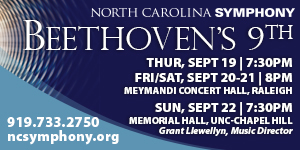One of the charms of a summer music festival is that a single program can include several different ensembles. For the second program of the 2011 Swannanoa Chamber Music Festival, ten musicians collaborated in three works. The performers included an ensemble that plays year round together (the Jasper String Quartet), an ensemble that plays occasionally together (the woodwind quintet includes three faculty members from the University of Akron and two others) and an ensemble put together on the spot for this festival (a pianist and accompanying strings).
Each year I look forward to hearing pianist Inessa Zaretsky, a regular at Swannanoa. For this program, she performed J.S. Bach’s Keyboard Concerto in D minor, S.1052, accompanied by the Jasper String Quartet. She set up with her back to the audience, the way a baroque soloist would be positioned, with the accompanying instruments to her left and right. (Baroque harpsichordists sat this way or else facing the audience. It was in the 1790s when Jan Ladislav Dussek first put a fortepiano sideways on the stage, showing his profile.) Zaretsky kept her runs clear and exposed, using a minimum of pedaling, and for the most part she used “terraced dynamics” (sudden changes in dynamic level) to keep the sense of the baroque. However, she used the power and abilities of the modern pianoforte appropriately, with a little pedal here and there and an occasional diminuendo. The result was crisp, clean, profoundly musical, and delightful in a way that Bach would have totally approved, even though he never saw a modern Steinway. How is it that a minor-key piece can be so joyful?
Johannes Brahms wrote his Variations and Fugue on a Theme by Handel, Op. 24, for solo piano. As always when he wrote for piano, he had in mind Clara Wieck Schumann, and it is not surprising that the work’s 25 variations and fugue require a piano virtuoso to do them justice. Mark Popkin arranged the work for woodwind quintet, and this version kept George Pope (flute), Cynthia Watson (oboe), David Bell (clarinet), Lynn Hileman (bassoon) and Bill Hoyt (French horn) quite busy. Popkin judiciously uses the timbre of the different instruments as a differentiating feature in several of the variations, switching from flute to piccolo in some cases, omitting flute or clarinet in others. Partly because of the use of timbre, I prefer the fugue in Popkin’s arrangement to the fugue played on the piano. The quintet was a little sloppy in their ensemble in variations about 13 to 15 but fully recovered and were dazzling in variation 20 (with its chromaticism and prolific accidentals) and beyond, including the final fugue.
The Jasper String Quartet is one of the spate of fine young string quartets this country has spawned in recent years. Playing professionally since 2006, the quartet is now located in New Haven, where it won the Horatio Parker Prize at Yale for “best fulfilling Dean Parker’s lofty musical ideals.” Lofty ideals propel quartets to tackle giant works, and Franz Schubert’s Quartet No. 14 in D minor is certainly a giant. Known as “Death and the Maiden,” the composer wrote it when he was 27 years of age and first realized that he would die young. The composer argues with death, fights with death, and tries to transcend death, but there is no question that he is describing his own mortality. The Jasper String Quartet’s technical proficiency is beyond question, and they clearly spend their time thinking deeply about the music they play. I found myself a day later wondering how, so full of life, these four young people (J. Freivogel, Sae Chonabayashi, Sam Quintal, and Rachel Henderson Freivogel) can grasp so well the intricacies of death.
This superior concert began in D minor (the relative minor key for F major), moved to the closely related B fllat major ,and concluded back in D minor. Conscious or unconscious, this sequence indicates the care taken by Swannanoa in presenting first-rate music. You have another chance to hear this concert at 7:30 p.m. on Tuesday evening, July 5, 2011, at Warren Wilson College in Swannanoa.











